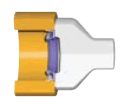
This chapter will provide the design engineer, who is familiar with radial shaft seal design parameters, the information needed to select and control the optimum sealing profile. ESP has created an organized Profile Selection Matrix that is customer friendly and easy to understand. Although it helps to be rehearsed in how system sealing parameters can affect lip and O.D. styles (see Design Chapter, Parameters section) it is not required. To fully utilize this section a brief explanation is needed to provide instruction and explanation of its intended use.
The Profile Selection Matrix is designed in rows and columns based on lip and case type designations. When moving from left to right the lip type remains constant as the case options change. In a similar manner, moving up and down reveals different lip options. The “type” designation and description are at the beginning of each column and row. These descriptions are intended to provide general usage information to aid in the selection process. For applications with limited profile choices the matrix has been reduced to single row format. If a profile option does not appear in the matrix please contact ESP Engineering.

The Operations Table was created to provide guidelines for the intended use of radial shaft seal profiles. This table can be used before and after profile selection. When using before, the type of lip style can be narrowed down by looking at the operational range and determining which profiles are designed to operate under these conditions. After a profile has been selected this table should be consulted to reaffirm proper selection. For parameters outside the ranges given for operation please contact ESP Engineering.
Hydrodynamic Aids can provide vital sealing assistance for a given lip style. This section provides a 2-D view of the air side angle with an aid style designation. For further explanation of how these aids are used in application refer to the Hydrodynamic Aids page in the Design Information chapter. The use of a hydrodynamic aid is represented by placing an “H” in front of the radial shaft seal profile designation. If a “TC” profile utilizes a hydrodynamic aid the designation would be “HTC”. More specifically, the aid style will be attached to the end of the profile designation. For a “U5” style aid, in the above example, the complete profile designation would be “HTCU5”.

The Design Specifications section is organized to provide recommendations of shaft and bore and seal tolerances. These specifications conform to radial shaft seal industry standards and were created to provide consistency for the customer. Checking to make sure the system components meet these specifications will help regulate and control an optimal environment.
The last section is an Installation Guide showing proper and improper methods. Detailed models have been created to show common tool styles and mistakes. Like the specifications section, installation methods are important for optimal sealing performance. Selecting the correct profile and regulating the design specifications are meaningless if the seal is cocked in the bore because of improper installation. Use this section as a guideline for installation method suggestions.